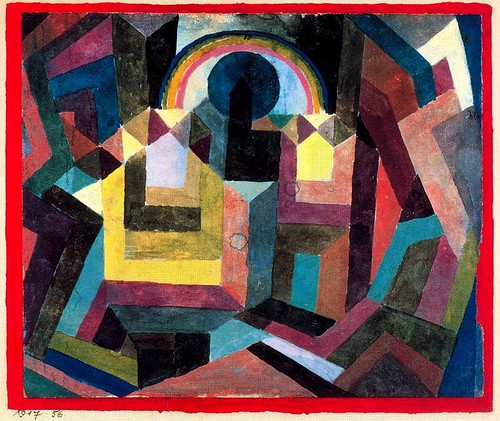Swiss-born painter, graphic artist, and printmaker Paul Klee has been involved in many modern art movements including Expressionism, Cubism, and Surrealism. Known for his colorful and varied fantasy art style depicting semi-abstract world dreamlike images, he is considered one of the best expressionist painters of the 20th century.

Image source: https://search.creativecommons.org/photos/3bd59d90-8e12-47d9-8d9e-ecb0644fd0d8 by Tulip Hysteria / Go to albums
A master of drawing, he also experimented endlessly with color theory in painting and was closely associated with the Ecole de Paris. He was greatly admired by Pablo Picasso and the surrealists. Klee himself defined his art as “taking a line for a walk”.

Image source: https://search.creativecommons.org/photos/a15b6129-adc5-48f7-9c38-3473563ec03d by The Public Domain Review
His masterpieces include:
- The Golden Fish (1925),
- Ad Parnassum (1932) a large but fragile work, produced in the pointillist style,
- Revolution of the Viaduct (1937).
In 1920, Walter Gropius invited Klee to join the faculty of the Bauhaus. A school of architecture and industrial design operating first in Weimar and then Dessau, it also included the study of arts and crafts. Nearly half of Klee‘s some 10,000 works (mainly small-scale watercolors and drawings on paper) were produced during the ten years he taught at the Bauhaus, and they vary widely. Some relate to the subject of his courses, to his preoccupation with the relationship of colors, such as Static-Dynamic Gradation, produced in 1923.

Image source: https://search.creativecommons.org/photos/15510081-5f87-4d09-a624-11e569c84a83 by Tulip Hysteria / Go to albums
Klee’s principal duty, like that of his fellow Bauhaus artists Kandinsky and László Moholy-Nagy, was to lecture in the basic design program on the mechanics of art. His lectures at the Bauhaus, recorded in more than 3,300 pages of notes and drawings, were a remarkable attempt to show how the formal elements of art, simple linear constructions, and geometric motifs, could be used to build complex symbolic compositions. Klee expounded his own methods in the Pädagogisches Skizzenbuch (1925, Pedagogical Sketchbook).
![[ K ] Paul Klee - Raumarchitekturen (Auf Kalt-Warm) ()](https://live.staticflickr.com/7147/6738911673_96a8bfd348.jpg)
Image source: https://search.creativecommons.org/photos/ff0b4549-1a39-416f-9ef0-3d350b11423f by Cea.
P. Klee was also a member of Die Blaue Vier (The Blue Four), with Kandinsky, Lyonel Feininger, and Alexej von Jawlensky, formed in 1923, they lectured and exhibited together in the USA in 1925.
What is the artistic style of Paul Klee?
In his painting and graphic art, Klee has developed an extraordinary range of techniques and styles attributable to his multiple interests. He wrote poems as a young man that inspired him years later for his paintings. He was interested in theatre and seriously considered music as a career, so much so that his paintings have been compared to music. Some, like portraits, have a theatrical quality, in others, the objects seem like floating notes of sheet music.
“Art does not reproduce the visible, rather, it makes visible”
Paul Klee

Image source: https://search.creativecommons.org/photos/c448683c-fbd4-4523-8787-2fc830dd6625 by oddsock
P. Klee was a natural draftsman, and thanks to long experimentation he became a master of color and tonality. Many of his works combine these skills. He uses a wide variety of color palettes, from nearly monochromatic to highly polychromatic. His works often have a fragile childlike quality and are usually small-scale. He often used geometric shapes, letters, numbers, and arrows, and combined them with figures of animals and people. Some works were completely abstract. Many of his works and their titles reflect his dry humor and various moods,some expressing political convictions. They often allude to poetry, music, and dreams and sometimes include words or musical notation.
![[ K ] Paul Klee - Tänzerin (1932)](https://live.staticflickr.com/5228/5853934821_d80f23db30.jpg)

Image source: https://search.creativecommons.org/photos/15337ff3-0de7-452f-acda-6b7e75bfe528 by y.caradec
Info sources:
For more references, please also visit: www.jbdesign.it/idesignpro

Comments are closed.